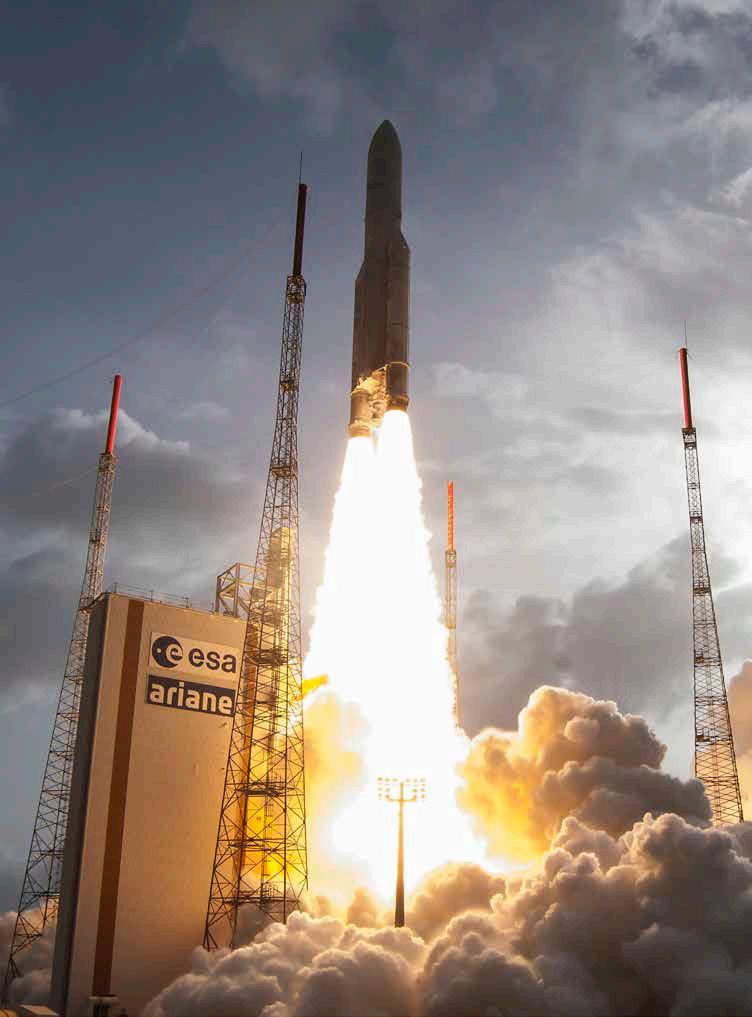
8 minute read
«Cork… don’t leave Earth without it»
© NASA
Let’s begin at the beginning. In the 1960s, while the world was adjusting to the “British Invasion” led by The Beatles, the premiere of «Breakfast at Tiffany’s» with Audrey Hepburn, and the first Woodstock festival, in the USA, Corticeira Amorim had its eyes set on space exploration programmes. Because the 1960s was also the decade in which Yuri Gagarin was launched into space and Neil Armstrong landed on the moon. The desire to pursue an achievement beyond the atmosphere transformed the company into the main Portuguese technological partner in providing insulation solutions for NASA and the European Space Agency (ESA).
Cork - which is has a low weight and is an extraordinary thermal insulator - is considered to be a fundamental component of ablation systems, that protect the interior of space vehicles, thereby preserving their integrity. There are only a few minutes between the moment when the spacecraft takes off, leaves the atmosphere and enters space. This is one of the most difficult human achievements, due to multiple factors: from extreme temperatures to supersonic speeds, the margin of error must be kept to zero. Corticeira Amorim has been supplying high quality products to the aerospace industry as a way to mitigate all possible constraints - from the Scout rockets in the 1960s to NASA’s iconic Space Shuttle in the mid-1980s, until the recent Falcon, Delta, Ariane or Veja projects. Luís Gil, the coordinator of the Division of Materials and Energy of the Portuguese Society of Materials, and a member of the Studies, Research and Renewables Department of the General Directorate of Energy and Geology (DGEG), stated in the work that commemorated the 150th anniversary of the Amorim group that «aerospace components must be lightweight structures that offer high resistance. Hence, various sandwich components, in particular based on composite materials, with reinforced sheets and lightweight core materials, are considered for this type of application». Cork, our principal raw material, offers all these characteristics. The researcher also adds that given that «cork composites have high resistance under static and dynamic loads, associated with the fact that they are lightweight, have a natural origin, good impact resistance and good thermal and acoustic insulation characteristics, which have therefore been considered for use in the cores of these sandwich components, and deliver a better performance compared to some high-performance foams.» Luís Gil adds says that cork and cork-based materials have been applied in several parts of the spacecraft, such as solid fuel tanks, lining of the engine, cone, nose and main body, and the lining of the connection rings of the external tank, passing through the tunnel covers and assembly areas, transition lids of the security systems and also in the heat shields of the space capsules.

Success stories
1960s Scout Mercury Spacecraft Gemini Spacecraft Saturn V 1970s Apollo Ariane 1 Viking Landers 1980s Ariane 2 Ariane 3 Titan III 1990s Space Shuttle Ariane 4 Titan IV Pegasus XL Today Mars Rovers Delta IV Beagle Pegasus XL Ariane 5 Atlas III-A Atlas V Vega Falcon 9 IXV Spacecraft
A trustworthy material
In terms of the reliability of cork, the history of aerospace has also been based on teamwork involving several people, such as Katherine Johnson, who correctly and manually calculated the atmospheric entry routes, John Glenn in the Friendship 7 mission, Darrel Davis, the NASA space engineer who highlighted the «ease of cutting and machining» this thermal protection material, or even Donald Thomas, an astronaut who flew in the Space Shuttle on four emblematic missions, who underlines the «fundamental role played by Corticeira Amorim in providing the thermal protection system of solid fuel boosters’. «Cork…isn’t just suitable for use on planet Earth! Cork has been an important component of the thermal protection systems of almost all rockets launched from Earth. I predict that there will be similar applications for cork as we visit other moons and planets in our solar system and eventually launch rockets from their surfaces back to Earth. Cork… don’t leave Earth without it!” Over recent years, Amorim Cork Composites (ACC) has collaborated in various development programmes of aerospace ablative materials, such as Aerofast and Ablamod, thereby opening up a new path for new generation solutions that are lighter more and efficient in terms of thermal protection. Corticeira Amorim’s composite cork business unit even has a factory in the state of Wisconsin, USA, that is dedicated to the production of solutions for the various components used in this sector, marketed under the TPS brand. António Rios de Amorim says that: “Aerospace equipment encompasses the world’s most demanding applications. NASA contacted us over 50 years ago and told us “your product is fantastic, it’s the only one that can solve a series of problems that we are confronting and for which we have never been able to find a solution”. Cork is a very good solution in this context and we must continue to capitalise on it». The designs of the ships and rockets may differ, but the safety of using cork continues to be unquestionable. Historically, cork supplied by Corticeira Amorim was used in the Scout, Mercury and Gemini Spacecraft, Saturn V and Apollo (various missions), Ariane 1,2 and 3, Space Shuttle and Titan, Pegasus XL and Delta IV, amongst many others. Currently, the most important applications are Vega, Falcon 9 and Artemis. The latter is from NASA, which has been creating efforts to “send astronauts back to the moon, Earth’s natural satellite”. The project, whose name is increasingly present on radio and television worldwide, foresees that a space station will be installed

© RUAG Schweiz AG
in a lunar orbit, which will serve as a basis for future expeditions to the Moon, as well as a launch pad to send astronauts into the highly-coveted territory: Mars.

© ESA
The terracota colour of the red planet Components for the space industry
Mars seems to be getting closer and closer. In 2020, Corticeira Amorim signed an agreement to supply cork-based components for the SpaceX rockets, produced by Elon Musk, founder and CEO of Tesla. More recently, in February 2021, Corticeira Amorim was involved in the mission that took the Perseverance rover to Mars, a vehicle that looked for signs of life linked to the past of the «red planet». Amorim also participated in an ESA project whose focus was the development of a thermal protection and shock absorbing shield on landing. This study also relied on the engineering certification authority, ISQ (the Welding and Quality Institute), the research institute, PIEP (Innovation Pole in Polymer Engineering) and the company, Stratosphere. These links underpin a curious common denominator: the terracotta colour of our stripped cork oak tree superimposed over the red hues of the planet Mars. Launched in 2012, ESA’s Vega rocket was equipped with technology produced by Amorim Cork Composites - TPS (Thermal Protection Systems). TPS materials are pioneers in the thermal protection of shields, thanks to a unique cork compound that has withstood decades of space travel. Built to support a weight of up to two and a half tons, the giant Vega rocket was designed to be able to orbit at altitudes between 300 and 1500 kilometres. Technically, in order to prevent overheating, cork was applied to the cone and the areas that are most sensitive to high temperatures, making this material the ideal choice for thermal insulation, vibration and fire resistance. In 2015, in the Intermediate eXperimental Vehicle (IXV) project, of the European Space Agency, cork was once again highlighted as part of the Ablative Thermal Protection System, conceived as part of a sophisticated engineering programme. The project was coordinated by Thales Alenia Space, from Italy, and the ESA, and also involved the collaboration of Amorim Cork Composites (ACC), which used TPS solutions – that are capable of protecting the spacecraft’s structure from the effects of the thermal environment, ranging from the initial phase, whole still on the ground, to re-entry into the atmosphere and the descent phase. ACC’s P50 composite agglomerate, which has a very high thermal insulation capacity, is used to cover the antennae and electronic devices. The paradigm in the aerospace industry is rapidly changing. «Over the coming years, we will observe an exponential increase in the number of public and private flights per year, not only for military, space exploration or communications purposes, but also for transporting passengers and goods. This new reality is placing great pressure on the price of each space launch and therefore the adoption of reusable materials is increasingly becoming a key requirement of this market», explains João Pedro Azevedo, Amorim Cork Composites’ CEO. He also reveals that the company is being challenged to produce components for the space industry, instead of just supplying materials “which then have to be machined and worked’. Scheduled for 2022, the Artemis project focuses on the concept of gender and racial equality and the right to discovery. Through the Artemis missions, NASA will land the first woman and first person of colour on the Moon, playing a pioneering role in offering new images of our galaxy. Corticeira Amorim is once again involved in this mission to send mankind into space and ensuring that cork continues to be used in North American rockets in the future. Orion, the capsule in which the crew will travel, will be lined with cork components. The Space Launch System, NASA’s new space launcher, which is expected to be available soon, will also incorporate cork. John Honeycutt, the head of the North American launch programme, the Artemis I mission and Space Launch System will prepare NASA for future missions and will make it possible to «increase our knowledge of how vehicles behave in relation to what already we understand about (…) our sensibilities associated with rocket design».











